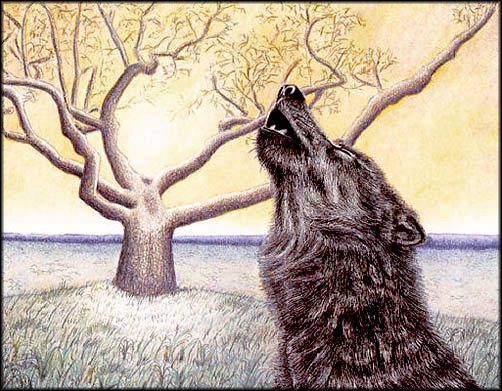Those who have a sincere interest in nature relate to animals in a special way. Some talk to them (especially their pets) as if they understand the very meaning of the spoken word, and on some level, perhaps they do. As fond as Gerry is of animals, he feels an equally kindred relationship to trees; that’s why it was important to him that the next piece in this series depicted a special one.
“Of all the trees I have met, the oak is by far the most sublime. With its roots firmly embedded in the earth and its powerful limbs reaching out to the sky, it represents the quintessence of nature.”
Back in the 1980s, he attended a powwow in Dighton, Massachusetts, and was privileged to be present at a Wampanoag “first light” ceremony at the site of this oak tree. This ritual is a celebration of life where traditional Wampanoag greet the morning sun, give thanks for life and pray for wisdom from the Creator. Before sunrise, a group led by a Wampanoag called Three Bears gathered at the tree. After making an offering of tobacco, Three Bears made a short statement about the importance the tree had to him and his people, then thanked the Creator for the gift of life.
“When we first arrived there, Three Bears walked over to the tree and touched it. When he did, I heard a very unusual and harmonious resonance which lasted just a few moments.” Gerry thought Three Bears had made the sound he heard so later that day spoke with him about it. Surprised that Gerry had heard it, he confided that it was not he but the tree that sounded that resonant melody. He said he often hears it when he goes there and believed it was the tree’s way of communicating a greeting.
In Gerry’s portrait of this tree he has attempted to represent it as spirit, as the essence of ancient knowledge. Its branches reaching out towards the rising sun, it embraces life itself. Even the shadow it casts is embedded in light. In the foreground is the black wolf, the animistic embodiment of Philip’s spirit, crying for his people to unite.
This venerable tree, according to tradition, was the place where Pometacom and his father Massasoit held ancient council with their people. Today known as the “Council Oak,” it stood in the old Pokanoket corn fields on the site of the only known Indian settlement in Dighton. After King Philip’s War, Indian title to this place was extinguished and the Wampanoag did not hold council there again until 1979. The growth of this great oak was slow in that light soil. Though not unusually tall, it had wide spreading branches which stood the onset of many storms. The trunk of this massive white oak was nearly six feet in diameter and it was possibly over five hundred years old. Today, the tree is no longer standing, having succumbed to the ravages of time. It’s unquestionably an ambassador of the past, but more importantly, it was a symbol of hope and survival.
